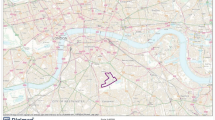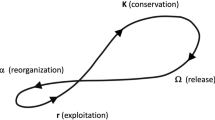Abstract
Using archaeological and historical data from eighteenth- and nineteenth-century haciendas in theParroquia de Yaxcabá, Yucatán, this paper demonstrates how documentary records can be employed to create diachronic archaeological explanations. Both the organization of production on the hacienda and the entrepreneurial strategies pursued by the estate owners. contribute to the form of the hacienda. The following analysis suggests quantitative and qualitative explanations for variation in hacienda size and architectural elaboration. The archaeological interpretations offer a reconsideration of processes of economic change in central Yucatán prior to the Caste War of 1847.
Similar content being viewed by others
References Cited
Abrams, E. M. (1994).How the Maya Built Their World: Energetics and Ancient Architecture, University of Texas Press, Austin.
Alexander, R. T. (1993)Colonial Period Archaeology of the Parroquia de Yaxcabá, Yucatán, México: An Enthnohistorical, and Site Structural Analysis, Unpublished Ph.D. dissertation, Department of Anthropology, University of New Mexico, Albuquerque.
Alexander, R. T. (1997). Late Colonial Period settlement patterns in Yaxcabá parish, Yucatán, México: Implications for the distribution of land and population before the Caste War. In Gasco, J., Smith, G., and Fournier-Garcia, P. (eds.)Approaches to the Historical Archaeology of Middle and South America, UCLA Institute of Archaeology, Monograph 38 (in press).
Altman, I., and Lockhart, J. (eds.) (1976).Provinces of Early Mexico: Variants of Spanish American Regional Evolution, UCLA Latin American Center, Los Angeles.
Archivo de la Mitra Emeritense (1784).Visita a Yaxcabá. Visitas Pastorales 1783–1784. Cathedral Archive, Mérida, Yucatán.
Archivo de la Mitra Emeritensen (1804).Visita a Yaxcabá. Visitas Pastorales 1803–1805, Cathedral Archive, Mérida, Yucatán.
Archivo de la Mitra Emeritense (1828).Visita a Yaxcabá Selección Joaquín Arrigunaga Peon, Caja 5, Ticul-Yotholin, Cathedral Archive, Mérida, Yucatán.
Archivo de la Mitra Emeritense (1829)visita a Sotuta. Selección Joaquín Arrigunaga Peon, Caja 4, Pencuyut-Teya, Cathedral Archive, Mérida, Yucatán.
Archivo Notarial del Estado de Yucatán, (1800–1850).Notarías. Registro Público de la Propiedad, Mérida, Yucatán.
Barth, F. (1966). Models of social organization.Royal Anthropological Institute, Occasional Papers No. 23, London.
Barth, F. (1967). Economic spheres in Darfur. In Firth, R. (ed.),Themes in Economic Anthropology, Tavistock, London.
Biblioteca Cresencio Carrillo y Ancona (1778).Declaraciones de diezmos en el Partido de Beneficios Altos y Bajos, son frutas de setenta y siete colectados en 1778, años, Mérida, Yucatán.
Biblioteca Cresencio Carrillo y Ancona (1845).1845 a 1847 Registro de las denuncias de terrenos baldíos, Mérida, Yucatán.
Borah, W. (1951).New Spain's Century of Depression, Iberoamericana 35, University of California Press, Berkeley.
Bracamonte y Sosa, P. (1984). Haciendas, Ranchos y Pueblos en Yucatán (1821–1847).Boletín de la Escuela de Ciencias Antropológicas de la Universidad de Yucatán 11(66): 3–12.
Bracamonte y Sosa, P. (1985). Sirvientes y Ganado en las Haciendas Yucatecas (1821–1847).Boletín de la Escuela de Ciencias Antropológicas de la Universidad de Yucatán 12(70): 3–15.
Bracamonte y Sosa, P. (1988). Haciendas y Ganados en el Noroeste de Yucatán, 1800–1850.Historia Mexicana 37(4): 613–639.
Bracamonte y Sosa, P. (1990). Sociedades de Sirvientes y Uso del Espacio en las Haciendas de Yucatán 1800–1860.Historia Mexicana 40 (1): 53–77.
Bricker, V. R. (1981).The Indian Christ, the Indian King: The Historical Substrate of Maya Myth and Ritual, University of Texas Press, Austin.
Carmack, R. M. (1986). Ethnohistory of the Guatemalan Colonial Indian. In Spores R. (ed.),Supplement to the Handbook of Middle American Indianas, Vol. 4.Ethnohistory. University of Texas Press, Austin, pp. 55–70.
Chance, J. K. (1986). Colonial ethnohistory of Oaxaca. In Spores, R. (ed.),Supplement to the Handbook of Middle American Indianas, Vol. 4.Ethnohistory, University of Texas Press, Austin, pp. 165–189.
Chance, J. K. (1996). Mesoamerica's ethnographic past.Ethnohistory 43(3): 379–403.
Charlton, T.H. (1986). Socioeconomic dimension of urban-rural relations in the Colonial Period basin of Mexico. In Spores, R. (ed.),Supplement to the Handbook of Middle American Indianas, Vol. 4 Ethnohistory, University of Texas Press, Austin, pp. 122–133.
Chevalier, F. (1963).Land and Society in Colonial Mexico: The Great Hacienda, University of California Press, Berkeley.
Cline, H. F. (1950). Related studies in early nineteenth century Yucatecan social history. Microfilm Collection of Manuscripts on Middle American, Cultural Anthropology No. 32, University of Chicago Library, Chicago.
Curtin, P. D. (1990).The Rise and Fall of the Plantation Complex, Cambridge University Press, Cambridge.
Deagan, K. (1982). Avenues of inquiry in historical archaeology. In Schiffer, M. B. (ed.),Advances in Archaeological Method and Theory, Vol. 5, Academic Press, New York, pp. 151–177.
Farriss, N. M. (1984).Maya Society Under Colonial Rule: The Collective Enterprise of Survival, Princeton University Press, Princeton, N.J.
Farriss, N. M. (1986) Indians in Colonial northern Yucatan. In Spores, R. (ed.),Supplement to the Handbook of Middle American Indianas, Vol. 4. Ethnohistory, University of Texas Press, Austin, pp. 88–102.
Garza Tarzana, S. G., and Kurjack, E. B. (1980).Atlas Arqueológico de Estado de Yucatán, 2 vols. IANH, Centro Regional del Sureste, Mexico City, Mexico.
Gibson, C. (1964).The Aztecs Under Spanish Rule: A History of the Indians of the Valley of Mexico, 1519–1810, Stanford University Press, Stanford, CA.
Hayden, B. (1994). Village approaches to complex societies. In Schwartz, G. M., and Falconer, S. E. (eds.),Archaeological Views from the Countryside: Village Communities in Early Complex Societies, Smithsonian Institution Press, Washington, DC, pp. 198–206.
Hunt, M. E. (1974).Colonial Yucatan: Town and Region in the Seventeenth Century, Ph.D. dissertation. University Microfilms, Ann Arbor, MI.
Johnson, A. W. (1971).Sharecroppers of the Sertão: Economics and Dependence on a Brazilian Plantation, Stanford University Press, Stanford, CA.
Jones, D. M. (1980).The Archaeology of Nineteenth Century Haciendas and Ranchos of Otumba and Apan, Basin of Mexico, Post-Conquest Developments in the Teotihuacan Valley, Mexico, Part 5, Research Report No. 2, Mesoamerican Research Colloquium, Department of Anthropology, The University of Iowa, Iowa City.
Little, B. J. (1994). People with history: An update on historical archaeology in the United States.Journal of Archaeological Method and Theory,1(1): 5–40.
MacLeod, M. J. (1973).Spanish Central America: A Socio-Economic History, 1520–1750, University of California Press, Berkeley.
McAlister, L. N. (1984).Spain and Portugal in the New World 1492–1700, University of Minnesota Press, Minneapolis.
Margolis, M. (1977). Historical perspectives on frontier agriculture as an adaptive strategy.American Ethnologist 4: 42–64.
Millet Cámara, L. (1985). Las Haciendas de Yucatán.Cuadernos de Arquitectura Virreinal 2: 34–41 (Facultad de Arquitectura de UNAM).
Patch, R. W. (1979).A Colonial Regime: Maya and Spaniard, in Yucatan, Ph.D. dissertation. University Microfilms, Ann Arbor, MI.
Patch, R. W. (1985). Agrarian change in eighteenth-century Yucatan.Hispanic American Historical Review 65(1): 21–49.
Patch, R. W. (1993).Maya and Spaniard in Yucatan, 1648–1812, Stanford University Press, Stanford, CA.
Reed, N. (1964).The Caste War of Yucatan, Stanford University Press, Stanford, CA.
Roys, R. L. (1939).The Titles of Ebtun, Carnegie Institution of Washington Publication No. 505, Washington, DC
Strickon, A. (1965). Hacienda and plantation in Yucatan: An historical-ecological consideration of the folk-urban continuum in Yucatan.América Indígena 25: 35–65.
Taylor, W. B. (1972).Landlord and Peasant in Colonial Oaxaca, Stanford University Press, Stanford, CA.
Turner, E. S., Turner, N. I., and Adams, R. E. W. (1981). Volumetric assessment, rank ordering, and Maya civic centers. In Asnmore, W. (ed.),Lowland Maya Settlement Patterns, University of New Mexico Press, Albuquerque, pp. 71–88.
Van Young, E. (1983). Mexican rural history since Chevalier: The historiography of the colonial hacienda.Latin American Research Review 18(3): 5–61.
Wilk, R. R. (1990). The built environment and Consumer decisions. In Kent, S. (ed.),Domestic Architecture and the Use of Space, Cambridge University Press, Cambridge, pp. 34–42.
Wolf, E. R. (1982).Europe and the People Without History, University of California Press, Berkeley.
Wolf, E. R., and Mintz, S. W. (1957). Haciendas and plantations in middle American and the Antilles.Social and Economic Studies 6: 380–411.
Author information
Authors and Affiliations
Rights and permissions
About this article
Cite this article
Alexander, R.T. Haciendas and economic change in Yucatán: Entrepreneurial strategies in the Parroquia de Yaxcabá, 1775–1850. J Archaeol Method Theory 4, 331–351 (1997). https://doi.org/10.1007/BF02428067
Issue Date:
DOI: https://doi.org/10.1007/BF02428067




